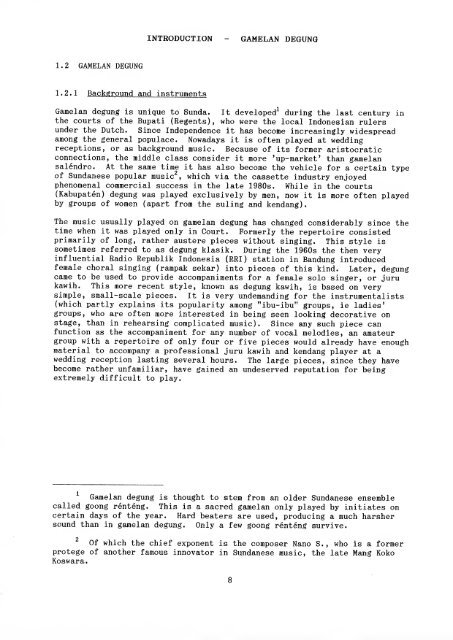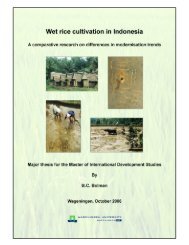Guide to Sundanese Music - Free EBooks Library
Guide to Sundanese Music - Free EBooks Library
Guide to Sundanese Music - Free EBooks Library
Create successful ePaper yourself
Turn your PDF publications into a flip-book with our unique Google optimized e-Paper software.
1.2 GAMELAN DEGUNG<br />
1*2. 1<br />
INTRODUCTION - GAMELAN DEGUNG<br />
Background and instruments<br />
Gamelan degung is unique <strong>to</strong> Sunda. It developed^ during the last century in<br />
the courts of the Bupati (Regents), who were the local Indonesian rulers<br />
under the Dutch. Since Independence It has become increasingly widespread<br />
among the general populace. Nowadays it is often played at wedding<br />
receptions, or as background music. Because of its former aris<strong>to</strong>cratic<br />
connections, the middle class consider it more 'up-market' than gamelan<br />
salendro. At the same time it has also become the vehicle for a certain type<br />
of <strong>Sundanese</strong> popular music^, which via the cassette industry enjoyed<br />
phenomenal commercial success in the late 1980s. While in the courts<br />
(Kabupat^n) degung was played exclusively by men, now it is more often played<br />
by groups of women (apart from the suling and kendang).<br />
The music usually played on gamelan degung has changed considerably since the<br />
time when it was played only in Court. Formerly the reper<strong>to</strong>ire consisted<br />
primarily of long, rather austere pieces without singing. This style is<br />
sometimes referred <strong>to</strong> as degung klasik. During the 1960s the then very<br />
influential Radio Republik Indonesia (RRI) station in Bandung introduced<br />
female choral singing (rampak sekar) in<strong>to</strong> pieces of this kind. Later, degung<br />
came <strong>to</strong> be used <strong>to</strong> provide accompaniments for a female solo singer, or juru<br />
kawih. This more recent style, known as degung kawih, is based on very<br />
simple, small-scale pieces. It is very undemanding for the instrumentalists<br />
(which partly explains its popularity among "ibu-ibu" groups, ie ladies'<br />
groups, who are often more interested in being seen looking decorative on<br />
stage, than in rehearsing complicated music). Since any such piece can<br />
function as the accompaniment for any number of vocal melodies, an amateur<br />
group with a reper<strong>to</strong>ire of only four or five pieces would already have enough<br />
material <strong>to</strong> accompany a professional juru kawih and kendang player at a<br />
wedding reception lasting several hours. The large pieces, since they have<br />
become rather unfamiliar, have gained an undeserved reputation for being<br />
extremely difficult <strong>to</strong> play.<br />
Gamelan degung is thought <strong>to</strong> stem from an older <strong>Sundanese</strong> ensemble<br />
called goong renteng. This is a sacred gamelan only played by initiates on<br />
certain days of the year. Hard beaters are used, producing a much harsher<br />
sound than in gamelan degung. Only a few goong renteng survive.<br />
Of which the chief exponent is the composer Nano S., who is a former<br />
protege of another famous innova<strong>to</strong>r in <strong>Sundanese</strong> music, the late Mang Koko<br />
Koswara.<br />
8








